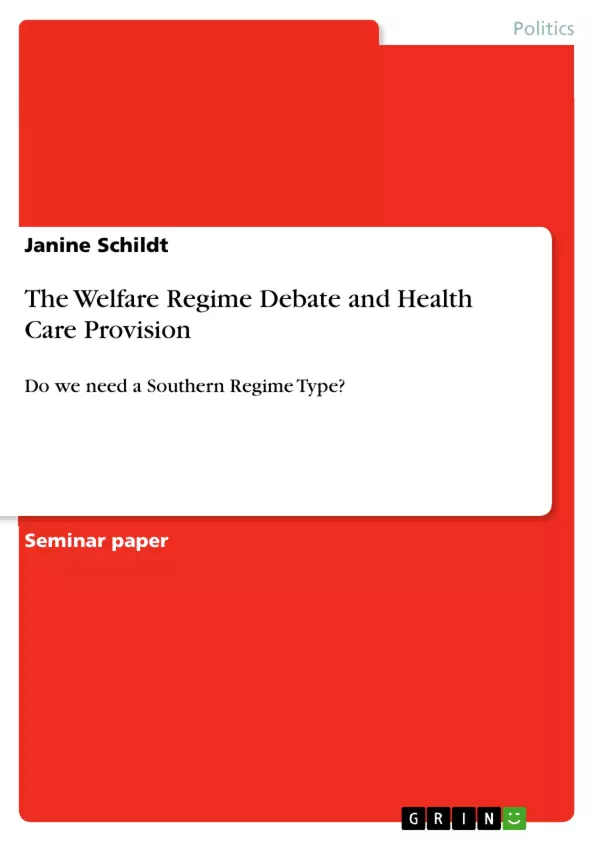The welfare regime typology of the Danish sociologist Gøesta Esping-Andersen has become a modern social science classic and is widely used as a theoretical foundation for all kinds of research projects. However, his three-folded model differentiating regimes on the basis of welfare provision has also been challenged. Many studies have criticized Esping-Andersen for his non-acknowledgement of a Southern welfare regime including Greece, Spain, Portugal and Italy (...). Historic circumstances have produced fragmented welfare states which provide partly extensive state-led services, e.g. in health care, but have very limited benefits in other areas. The question remains whether “the peculiarities of these cases are variations within a distinct overall logic [or] a wholly different logic per se”, as Esping-Andersen (1999, p.90) has formulated it.
Claire Bamba (2005) has challenged Esping-Andersen’s welfare regime typology focusing on health care and identified two additional subcategories. Bamba argued that health care provision is a very distinguished feature of the welfare state and countries may follow a different logic in their health care services than they pursue in other branches of their welfare states (...).
This paper argues that Southern countries can be included in Esping-Andersen’s typology when looking at welfare areas independently and thus do not form an independent regime. The only clear difference they show is that their health care services and other areas of welfare state support follow different logics, which is also true for other countries such as the United Kingdom. Moreover, following Katrougalos (1996) it is argued that the distinctive features of Southern countries are based on the incompleteness of the development of their welfare states which have undergone considerable transformations in the last 30 years.
The paper is structured as follows: Adjoining this introduction, the second chapter outlines Esping-Andersen’s welfare typology, summarizes the most prominent criticisms and portraits the state of research on the Southern regime type. The third chapter gives overviews of the health care systems in Southern countries and compares them to see whether they really form a new welfare regime. The fourth chapter outlines Claire Bamba’s decommodification index for health care and compares it to data from Southern countries while chapter five summarizes the findings and draws up a conclusion.
Inhaltsverzeichnis (Table of Contents)
- Introduction
- The Welfare Regime Debate
- Esping-Andersen's Three Worlds of Welfare Capitalism
- Criticism of Esping-Andersen
- The Southern Regime Type
- Health Care in Southern Countries
- The Spanish Health Care System
- The Portuguese Health Care System
- The Italian Health Care System
- The Greek Health Care System
- A Southern Regime in Health Care?
- Measuring Welfare Regimes in Health Care - Where do we group the Southern Countries?
- Clare Bamba's Decommodification Index for Health Care
- Applying the Decommodification Index for Health Care to the Southern Welfare Regime
- Conclusion
Zielsetzung und Themenschwerpunkte (Objectives and Key Themes)
This paper explores the concept of a distinct Southern welfare regime type, specifically focusing on health care provision in Southern European countries. It examines the validity of including these countries in Esping-Andersen's existing typology, taking into account criticisms of his model and considering the unique features of Southern welfare systems.
- Analysis of Esping-Andersen's three-world welfare regime typology and its limitations.
- Exploration of the specific characteristics of health care systems in Southern European countries (Spain, Portugal, Italy, Greece).
- Examination of the argument for a distinct Southern welfare regime type, considering its historical and cultural context.
- Application of Claire Bamba's decommodification index to assess the placement of Southern countries within the broader welfare regime typology.
- Discussion of the extent to which Southern countries form a unique welfare regime or can be integrated into existing typologies.
Zusammenfassung der Kapitel (Chapter Summaries)
The paper begins by outlining Esping-Andersen's influential three-world welfare regime typology, which categorizes welfare states based on decommodification, social stratification, and the public-private mix. The chapter then discusses critiques of this typology, including its limited geographical scope and its neglect of gender perspectives.
The third chapter delves into the health care systems of Southern European countries (Spain, Portugal, Italy, and Greece), examining their specific features and comparing them to other welfare regimes. The chapter aims to determine whether these countries share a common logic in their health care provision that distinguishes them from other models.
The fourth chapter introduces Claire Bamba's decommodification index for health care, which provides a framework for analyzing the extent to which health care is a right rather than a market commodity. The chapter applies this index to the data of Southern countries, comparing their results to other welfare regimes and further exploring the potential for a distinct Southern welfare regime type.
Schlüsselwörter (Keywords)
This paper explores the concept of a Southern welfare regime type, focusing on health care provision in Southern European countries. Key topics include welfare regime typologies, decommodification, health care systems, historical and cultural influences, and the debate surrounding the classification of Southern countries within the broader welfare state framework.
- Quote paper
- Janine Schildt (Author), 2010, The Welfare Regime Debate and Health Care Provision, Munich, GRIN Verlag, https://www.grin.com/document/159976



